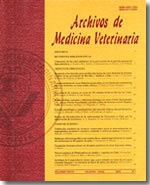Protective effect of a non virulent strain against infection of a highly virulent strain of Trypanosoma cruzi in a murine model
Main Article Content
Abstract
This study was carried out to compare the infection course of Trypanosoma cruzi in the ACA inbred mouse strain inoculated with 2000 blood trypomastigotes of the Tulahuen strain and the Colombian Munantá strain. Parasitaemia and mortality rates showed different patterns for both strains of the parasite. All the Tulahuen infected mice died within 3 weeks after infection, in contrast, all mice infected with the Munantá strain survived, although they showed higher level of parasitaemia. These results are in agreement with previous findings suggesting poor correlation between death and parasitaemia level. The histopathological study showed different degrees of parasitism and inflammatory infiltrates in the heart, according to the parasite strain. The infection with the Munantá strain resulted in scarce parasitism and discrete inflammatory infiltrate. However, severe inflammation and tissue parasitism were observed in the Tulahuen infected mice. The protective effect of the non virulent Munantá strain against infection with the virulent Tulahuen strain was studied. When the Tulahuen strain was inoculated into mice after a challenge with the Munantá strain, parasitaemia was more controlled, and all the mice survived, showing lower inflammatory infiltration and a low number of pseudocysts. Application of these results to vaccine development is proposed.

